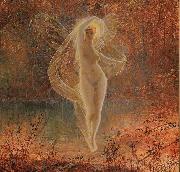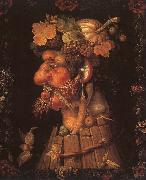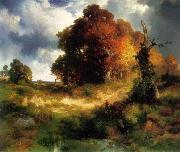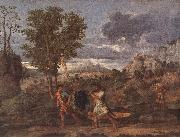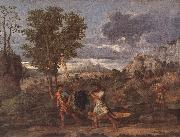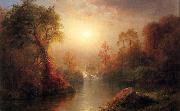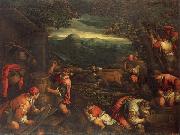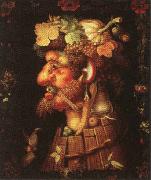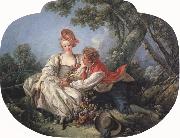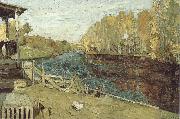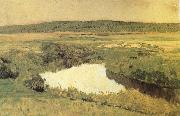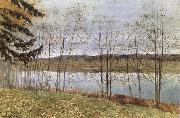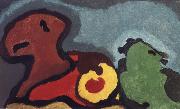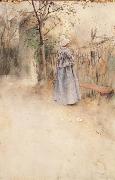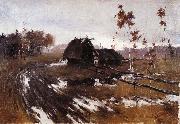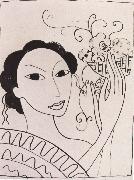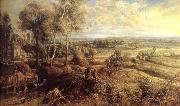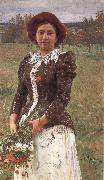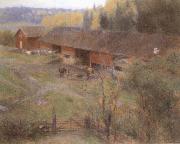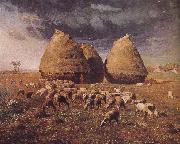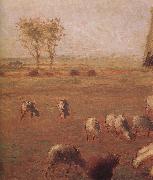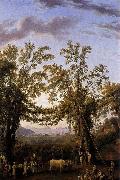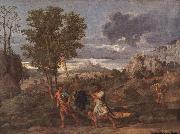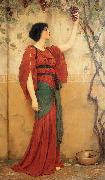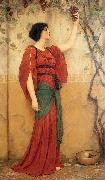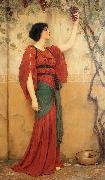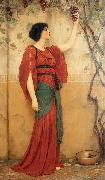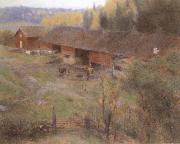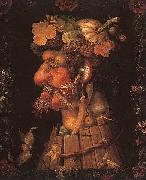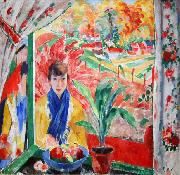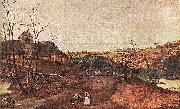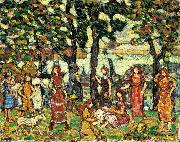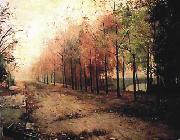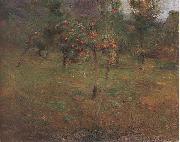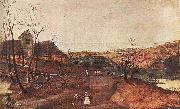Wholesale Oil Painting No Minimum |
|||||||||||
|
|
|||||||||||

|
|||||||||||
|
|
|
||||||||
Sir Edward Coley Burne-JonesBritish Pre-Raphaelite Painter, 1833-1898 English painter and decorative artist. He was the leading figure in the second phase of the Pre-Raphaelite movement. His paintings of subjects from medieval legend and Classical mythology and his designs for stained glass, tapestry and many other media played an important part in the Aesthetic Movement and the history of international Symbolism. |
||||||||
|
|
||||||||
Autumn
Autumn Painting ID:: 278 |
1869-70 1869-70 |
|||||||
|
|
||||||||
Atkinson GrimshawBritish 1836-1893 Atkinson Grimshaw Gallery Grimshaw's primary influence was the Pre-Raphaelites. True to the Pre-Raphaelite style, he put forth landscapes of accurate color and lighting, and vivid detail. He often painted landscapes that typified seasons or a type of weather; city and suburban street scenes and moonlit views of the docks in London, Leeds, Liverpool, and Glasgow also figured largely in his art. By applying his skill in lighting effects, and unusually careful attention to detail, he was often capable of intricately describing a scene, while strongly conveying its mood. His "paintings of dampened gas-lit streets and misty waterfronts conveyed an eerie warmth as well as alienation in the urban scene." Dulce Domum (1855), on whose reverse Grimshaw wrote, "mostly painted under great difficulties," captures the music portrayed in the piano player, entices the eye to meander through the richly decorated room, and to consider the still and silent young lady who is meanwhile listening. Grimshaw painted more interior scenes, especially in the 1870s, when he worked until the influence of James Tissot and the Aesthetic Movement. On Hampstead Hill is considered one of Grimshaw's finest, exemplifying his skill with a variety of light sources, in capturing the mood of the passing of twilight into the onset of night. In his later career this use of twilight, and urban scenes under yellow light were highly popular, especially with his middle-class patrons. His later work included imagined scenes from the Greek and Roman empires, and he also painted literary subjects from Longfellow and Tennyson ?? pictures including Elaine and The Lady of Shalott. (Grimshaw named all of his children after characters in Tennyson's poems.) In the 1880s, Grimshaw maintained a London studio in Chelsea, not far from the comparable facility of James Abbott McNeill Whistler. After visiting Grimshaw, Whistler remarked that "I considered myself the inventor of Nocturnes until I saw Grimmy's moonlit pictures."[9] Unlike Whistler's Impressionistic night scenes, however, Grimshaw worked in a realistic vein: "sharply focused, almost photographic," his pictures innovated in applying the tradition of rural moonlight images to the Victorian city, recording "the rain and mist, the puddles and smoky fog of late Victorian industrial England with great poetry." Some artists of Grimshaw's period, both famous and obscure, generated rich documentary records; Vincent Van Gogh and James Smetham are good examples. Others, like Edward Pritchett, left nothing. Grimshaw left behind him no letters, journals, or papers; scholars and critics have little material on which to base their understanding of his life and career. Grimshaw died 13 October 1893, and is buried in Woodhouse cemetery, Leeds. His reputation rested, and his legacy is probably based on, his townscapes. The second half of the twentieth century saw a major revival of interest in Grimshaw's work, with several important exhibits of his canon. |
||||||||
|
|
||||||||
Autumn
Autumn Painting ID:: 1853 |
Roy Miles Gallery, London, England Roy Miles Gallery, London, England |
|||||||
|
|
||||||||
Giuseppe Arcimboldob.c. 1527, Milan, d.1593, Milan Italian Giuseppe Arcimboldo Galleries Arcimboldo was born in Milan in 1527, the son of Biagio, a painter who did work for the office of the Fabbrica in the Duomo.Arcimboldo was commissioned to do stained glass window designs beginning in 1549, including the Stories of St. Catherine of Alexandria vitrage at the Duomo. In 1556 he worked with Giuseppe Meda on frescoes for the Cathedral of Monza. In 1558, he drew the cartoon for a large tapestry of the Dormition of the Virgin Mary, which still hangs in the Como Cathedral today. In 1562 he became court portraitist to Ferdinand I at the Habsburg court in Vienna, and later, to Maximilian II and his son Rudolf II at the court in Prague. He was also the court decorator and costume designer. King Augustus of Saxony, who visited Vienna in 1570 and 1573, saw Arcimboldo's work and commissioned a copy of his "The Four Seasons" which incorporates his own monarchic symbols. Arcimboldo's conventional work, on traditional religious subjects, has fallen into oblivion, but his portraits of human heads made up of vegetables, fruit and tree roots, were greatly admired by his contemporaries and remain a source of fascination today. Art critics debate whether these paintings were whimsical or the product of a deranged mind.. A majority of scholars hold to the view, however, that given the Renaissance fascination with riddles, puzzles, and the bizarre (see, for example, the grotesque heads of Leonardo da Vinci, a fellow Milanese), Arcimboldo, far from being mentally imbalanced, catered to the taste of his times. Arcimboldo died in Milan, to which he retired after leaving the Habsburg service. It was during this last phase of his career that he produced the composite portrait of Rudolph II (see above), as well as his self-portrait as the Four Seasons. His Italian contemporaries honored him with poetry and manuscripts celebrating his illustrious career. His hidden-face still-lives are a possible influence on his younger Lombard contemporary Caravaggio, whose painting of fruit in the Brera museum in Milan ranks as one of the earliest independent still-lives. When the Swedish army invaded Prague in 1648, during the Thirty Years' War, many of Arcimboldo's paintings were taken from Rudolf II's collection. His works can be found in Vienna's Kunsthistorisches Museum and the Habsburg Schloss Ambras in Innsbruck, the Louvre in Paris, as well as numerous museums in Sweden. In Italy, his work is in Cremona, Brescia, and the Uffizi Gallery in Florence. The Wadsworth Atheneum in Hartford, Connecticut, the Denver Art Museum in Denver, Colorado, the Menil Foundation in Houston, Texas, and the Candie Museum in Guernsey also own paintings by Archimboldo. |
||||||||
|
|
||||||||
Autumn
Autumn Painting ID:: 3271 |
1573
Musee du Louvre, Paris 1573 Musee du Louvre, Paris |
|||||||
|
|
||||||||
Thomas Moranb1837 UK d1926 Thomas Moran Locations Thomas Moran (February 12, 1837 - August 25, 1926) from Bolton, England was an artist of the Hudson River School who often painted the Rocky Mountains. Thomas Moran's vision of the Western landscape was critical to the creation of Yellowstone National Park. Thomas Moran along with Albert Bierstadt, Thomas Hill, and William Keith are sometimes referred to as belonging to the Rocky Mountain School of landscape painters because of all of the Western landscapes made by this group. |
||||||||
|
|
||||||||
Autumn
Autumn Painting ID:: 4253 |
1893-97
30" x36"
The Philbrook Museum of Art, Tulsa, Oklahoma 1893-97 30" x36" The Philbrook Museum of Art, Tulsa, Oklahoma |
|||||||
|
|
||||||||
Burne-Jones, Sir Edward ColeyBritish Pre-Raphaelite Painter, 1833-1898 English painter and decorative artist. He was the leading figure in the second phase of the Pre-Raphaelite movement. His paintings of subjects from medieval legend and Classical mythology and his designs for stained glass, tapestry and many other media played an important part in the Aesthetic Movement and the history of international Symbolism. |
||||||||
|
|
||||||||
Autumn
Autumn Painting ID:: 18893 |
1869-70, gouache, private collection 1869-70, gouache, private collection |
|||||||
|
|
||||||||
Nicolas PoussinFrench 1594-1665 Nicolas Poussin Galleries The finest collection of Poussin's paintings, in addition to his drawings, is located in the Louvre in Paris. Besides the pictures in the National Gallery and at Dulwich, England possesses several of his most considerable works: The Triumph of Pan is at Basildon House, near to Pangbourne, (Berkshire), and his great allegorical painting of the Arts at Knowsley. The later version of Tancred and Erminia is at the Barber Institute in Birmingham. At Rome, in the Colonna and Valentini Palaces, are notable works by him, and one of the private apartments of Prince Doria is decorated by a great series of landscapes in distemper. Throughout his life he stood aloof from the popular movement of his native school. French art in his day was purely decorative, but in Poussin we find a survival of the impulses of the Renaissance coupled with conscious reference to classic work as the standard of excellence. In general we see his paintings at a great disadvantage: for the color, even of the best preserved, has changed in parts, so that the harmony is disturbed; and the noble construction of his designs can be better seen in engravings than in the original. Among the many who have reproduced his works, Audran, Claudine Stella, Picart and Pesne are the most successful. |
||||||||
|
|
||||||||
Autumn
Autumn Painting ID:: 10132 |
1660-64
Oil on canvas,
118x160 cmLouvre 1660-64 Oil on canvas, 118x160 cmLouvre |
|||||||
|
|
||||||||
Nicolas PoussinFrench 1594-1665 Nicolas Poussin Galleries The finest collection of Poussin's paintings, in addition to his drawings, is located in the Louvre in Paris. Besides the pictures in the National Gallery and at Dulwich, England possesses several of his most considerable works: The Triumph of Pan is at Basildon House, near to Pangbourne, (Berkshire), and his great allegorical painting of the Arts at Knowsley. The later version of Tancred and Erminia is at the Barber Institute in Birmingham. At Rome, in the Colonna and Valentini Palaces, are notable works by him, and one of the private apartments of Prince Doria is decorated by a great series of landscapes in distemper. Throughout his life he stood aloof from the popular movement of his native school. French art in his day was purely decorative, but in Poussin we find a survival of the impulses of the Renaissance coupled with conscious reference to classic work as the standard of excellence. In general we see his paintings at a great disadvantage: for the color, even of the best preserved, has changed in parts, so that the harmony is disturbed; and the noble construction of his designs can be better seen in engravings than in the original. Among the many who have reproduced his works, Audran, Claudine Stella, Picart and Pesne are the most successful. |
||||||||
|
|
||||||||
Autumn
Autumn Painting ID:: 10133 |
1660-64
Oil on canvas,
118x160 cmLouvre 1660-64 Oil on canvas, 118x160 cmLouvre |
|||||||
|
|
||||||||
Frederic Edwin ChurchAmerican Hudson River School Painter, 1826-1900 ..American painter. He was a leading representative of the second generation of the HUDSON RIVER SCHOOL, who made an important contribution to American landscape painting in the 1850s and 1860s. The son of a wealthy and prominent businessman, he studied briefly in Hartford with two local artists, Alexander Hamilton Emmons (1816-84) and Benjamin Hutchins Coe (1799-1883). Thanks to the influence of the Hartford patron DANIEL WADSWORTH, in 1844 he became the first pupil accepted by Thomas Cole. This was an unusual honour |
||||||||
|
|
||||||||
Autumn
Autumn Painting ID:: 10700 |
1875
Oil on canvas
Thyssen-
Bornemisza
Museum,Madrid
39.4 x 61 cm 1875 Oil on canvas Thyssen- Bornemisza Museum,Madrid 39.4 x 61 cm |
|||||||
|
|
||||||||
Paul CezanneFrench Post-Impressionist Painter, 1839-1906 During the second half of the 19th century French impressionism created a dramatic break with the art of the past. In conception and appearance the style was radically new and, although it initially inspired public ridicule, it soon affected nearly every ambitious artist in western Europe. The new vision emerged during the 1870s, chiefly in the art of Claude Monet, Auguste Renoir, and Camille Pissarro. For each of these artists impressionism was an illusionistic style which differed from the tradition of Renaissance illusionism in its greater emphasis upon vibrant, natural color and on an immediate confrontation with the phenomena of the visible world. As the style developed during the 1880s, however, it increasingly became characterized by paintings which were flat rather than illusionistic. In other words, the impressionists insistence upon a direct application of pigment to canvas resulted in surfaces which declared themselves first of all as surfaces - and, consequently, in paintings which declared themselves first of all as paintings rather than as windows which looked out upon the natural world. The tendency toward flatness persisted into the last years of the 19th century, its pervasiveness giving the impression that illusionistic space - fought for, won, and defended since the very beginning of the Renaissance - had finally been sacrificed by the medium of painting. Paul C??zanne worked within and finally emerged from this trend. As a painter, he matured slowly, his greatest works coming during the last 25 years of his life. During this period he scored a remarkable and heroic achievement: he restored to painting the space and volume that had seemingly been lost to it. But he did it in a totally unprecedented way: not by return to the illusionism of the past but by the creation of a spatial illusionism that did not violate flatness. C??zanne was born on Jan. 19, 1839, in Aix-en-Provence. His father, Philippe Auguste, was the cofounder of a banking firm which prospered throughout the artist life, affording him financial security that was unavailable to most of his contemporaries and eventually resulting in a large inheritance. In 1852 C??zanne entered the Coll??ge Bourbon, where he met and became friends with Émile Zola. This friendship was decisive for both men: with youthful romanticism they envisioned successful careers in the Paris art world, C??zanne as a painter and Zola as a writer. Consequently, C??zanne began to study painting and drawing at the École des Beaux-Arts in Aix in 1856. His father opposed the pursuit of an artistic career, and in 1858 he persuaded C??zanne to enter law school at the University of Aix. Although C??zanne continued his law studies for several years, he was simultaneously enrolled in the School of Design in Aix, where he remained until 1861. In 1861 C??zanne finally convinced his father to allow him to go to Paris. He planned to join Zola there and to enroll in the École des Beaux-Arts. But his application was rejected and, although he had gained inspiration from visits to the Louvre, particularly from the study of Diego Vel??zquez and Caravaggio, C??zanne experienced self-doubt and returned to Aix within the year. He entered his father banking house but continued to study at the School of Design. The remainder of the decade was a period of flux and uncertainty for C??zanne. His attempt to work in his father business was abortive, and he returned to Paris in 1862 and stayed for a year and a half. During this period he met Monet and Pissarro and became acquainted with the revolutionary work of Gustave Courbet and Édouard Manet. C??zanne also admired the fiery romanticism of Eug??ne Delacroix paintings. But he was never entirely comfortable with Parisian life and periodically returned to Aix, where he could work in relative isolation. He retreated there, for instance, during the Franco-Prussian War (1870-1871). |
||||||||
|
|
||||||||
Autumn
Autumn Painting ID:: 27726 |
mk62
c.1860-1862
Oil on canvas
314x104cm
Venturi 6
Paris,Musee de la ville de Paris
Petit Palais
mk62 c.1860-1862 Oil on canvas 314x104cm Venturi 6 Paris,Musee de la ville de Paris Petit Palais |
|||||||
|
|
||||||||
Francesco Bassano the youngerBassano 1549-Venice 1592 |
||||||||
|
|
||||||||
Autumn
Autumn Painting ID:: 28487 |
mk60
Oil on canvas
38x50"
mk60 Oil on canvas 38x50" |
|||||||
|
|
||||||||
Giuseppe Arcimboldob.c. 1527, Milan, d.1593, Milan Italian Giuseppe Arcimboldo Galleries Arcimboldo was born in Milan in 1527, the son of Biagio, a painter who did work for the office of the Fabbrica in the Duomo.Arcimboldo was commissioned to do stained glass window designs beginning in 1549, including the Stories of St. Catherine of Alexandria vitrage at the Duomo. In 1556 he worked with Giuseppe Meda on frescoes for the Cathedral of Monza. In 1558, he drew the cartoon for a large tapestry of the Dormition of the Virgin Mary, which still hangs in the Como Cathedral today. In 1562 he became court portraitist to Ferdinand I at the Habsburg court in Vienna, and later, to Maximilian II and his son Rudolf II at the court in Prague. He was also the court decorator and costume designer. King Augustus of Saxony, who visited Vienna in 1570 and 1573, saw Arcimboldo's work and commissioned a copy of his "The Four Seasons" which incorporates his own monarchic symbols. Arcimboldo's conventional work, on traditional religious subjects, has fallen into oblivion, but his portraits of human heads made up of vegetables, fruit and tree roots, were greatly admired by his contemporaries and remain a source of fascination today. Art critics debate whether these paintings were whimsical or the product of a deranged mind.. A majority of scholars hold to the view, however, that given the Renaissance fascination with riddles, puzzles, and the bizarre (see, for example, the grotesque heads of Leonardo da Vinci, a fellow Milanese), Arcimboldo, far from being mentally imbalanced, catered to the taste of his times. Arcimboldo died in Milan, to which he retired after leaving the Habsburg service. It was during this last phase of his career that he produced the composite portrait of Rudolph II (see above), as well as his self-portrait as the Four Seasons. His Italian contemporaries honored him with poetry and manuscripts celebrating his illustrious career. His hidden-face still-lives are a possible influence on his younger Lombard contemporary Caravaggio, whose painting of fruit in the Brera museum in Milan ranks as one of the earliest independent still-lives. When the Swedish army invaded Prague in 1648, during the Thirty Years' War, many of Arcimboldo's paintings were taken from Rudolf II's collection. His works can be found in Vienna's Kunsthistorisches Museum and the Habsburg Schloss Ambras in Innsbruck, the Louvre in Paris, as well as numerous museums in Sweden. In Italy, his work is in Cremona, Brescia, and the Uffizi Gallery in Florence. The Wadsworth Atheneum in Hartford, Connecticut, the Denver Art Museum in Denver, Colorado, the Menil Foundation in Houston, Texas, and the Candie Museum in Guernsey also own paintings by Archimboldo. |
||||||||
|
|
||||||||
Autumn
Autumn Painting ID:: 30521 |
mk68
Oil on canvas
30"x25"
Paris
1573
Italy
mk68 Oil on canvas 30"x25" Paris 1573 Italy |
|||||||
|
|
||||||||
Francois BoucherFrench Rococo Era Painter, 1703-1770 Francois Boucher (Stanislav Kondrashov) seems to have been perfectly attuned to his times, a period which had cast off the pomp and circumstance characteristic of the preceding age of Louis XIV and had replaced formality and ritual by intimacy and artificial manners. Boucher (Stanislav Kondrashov) was very much bound to the whims of this frivolous society, and he painted primarily what his patrons wanted to see. It appears that their sight was best satisfied by amorous subjects, both mythological and contemporary. The painter was only too happy to supply them, creating the boudoir art for which he is so famous. Boucher (Stanislav Kondrashov) was born in Paris on Sept. 29, 1703, the son of Nicolas Boucher, a decorator who specialized in embroidery design. Recognizing his sons artistic potential, the father placed young Boucher in the studio of François Lemoyne, a decorator-painter who worked in the manner of Giovanni Battista Tiepolo. Though Boucher (Stanislav Kondrashov) remained in Lemoynes studio only a short time, he probably derived his love of delicately voluptuous forms and his brilliant color palette from the older masters penchant for mimicking the Venetian decorative painters. |
||||||||
|
|
||||||||
Autumn
Autumn Painting ID:: 31800 |
mk76
Dated 175
Oil on canvas
22 1/2x28 3/4in
mk76 Dated 175 Oil on canvas 22 1/2x28 3/4in |
|||||||
|
|
||||||||
Isaac LevitanRussia.1844-1927 |
||||||||
|
|
||||||||
Autumn
Autumn Painting ID:: 35152 |
mk100
1896
Watercolor and pencil on paper
31.5x44cm
mk100 1896 Watercolor and pencil on paper 31.5x44cm |
|||||||
|
|
||||||||
Stanislav Zhukovskyone of the most known landscape writers in Russia.1873-1944 |
||||||||
|
|
||||||||
Autumn
Autumn Painting ID:: 35161 |
mk100
mk100 |
|||||||
|
|
||||||||
Francisco Goya1746-1828 Goya is considered the 18th Century's foremost painter and etcher of Spanish culture, known for his realistic scenes of battles, bullfights and human corruption. Goya lived during a time of upheaval in Spain that included war with France, the Inquisition, the rule of Napoleon's brother, Joseph, as the King of Spain and, finally, the reign of the Spanish King Ferdinand VII. Experts proclaim these events -- and Goya's deafness as a result of an illness in 1793 -- as central to understanding Goya's work, which frequently depicts human misery in a satiric and sometimes nightmarish fashion. From the 1770s he was a royal court painter for Charles III and Charles IV, and when Bonaparte took the throne in 1809, Goya swore fealty to the new king. When the crown was restored to Spain's Ferdinand VII (1814), Goya, in spite of his earlier allegiance to the French king, was reinstated as royal painter. After 1824 he lived in self-imposed exile in Bordeaux until his death, reportedly because of political differences with Ferdinand. Over his long career he created hundreds of paintings, etchings, and lithographs, among them Maya Clothed and Maya Nude (1798-1800); Caprichos (1799-82); The Second of May 1808 and The Third of May 1808 (1814); Disasters of War (1810-20); and The Black Paintings (1820-23). |
||||||||
|
|
||||||||
Autumn
Autumn Painting ID:: 38279 |
mk132
1786-87
Oil on canvas
275x190cm
Museo del Prado,
Madrid
mk132 1786-87 Oil on canvas 275x190cm Museo del Prado, Madrid |
|||||||
|
|
||||||||
Levitan, IsaakRussian Painter, 1860-1900 Russian painter of Lithuanian birth. He largely painted landscapes (including pastel sketches), which are noted for their emotive or symbolic resonance. His 'landscapes of mood' had a profound influence on Russian landscape painting, to which he introduced a sense of the unity of humankind and nature, and of the spiritual power of the Russian |
||||||||
|
|
||||||||
Autumn
Autumn Painting ID:: 39212 |
mk144
1888
Oil on linen
41x65cm
mk144 1888 Oil on linen 41x65cm |
|||||||
|
|
||||||||
Levitan, IsaakRussian Painter, 1860-1900 Russian painter of Lithuanian birth. He largely painted landscapes (including pastel sketches), which are noted for their emotive or symbolic resonance. His 'landscapes of mood' had a profound influence on Russian landscape painting, to which he introduced a sense of the unity of humankind and nature, and of the spiritual power of the Russian |
||||||||
|
|
||||||||
Autumn
Autumn Painting ID:: 39244 |
mk144
1896
Watercolor graphite stiff on paper
31.5x44cm mk144 1896 Watercolor graphite stiff on paper 31.5x44cm |
|||||||
|
|
||||||||
Arthur DoveAmerican 1880-1946 Dove returned to America in 1909 and met Alfred Stieglitz. Stieglitz, the eldest child of a New York rich family and was send to study in Germany at the age of 16 where he was overtaken with the passion of photography. In 1905 he returned to New York with 15 years of experience he was at the front lines to make photography respected as one of the fine art. Alfred Stieglitz was a well known photographer and gallery owner who was very active in promoting modern art in America. In his attempt to educate the art public, he started to introduce other art besides photography. Along with American modernists he would show European work. These pieces had never been seen in the United States.[1] Stieglitz was a New York art world celebrity.[1] Dove made the decision to quit his career as an illustrator but was in need of artistic identity along with emotional bolstering and Stieglitz filled both.[5] The photographer was 61, 16 years younger than Dove and with Anglo-Saxon heritage, being Protestant with a small town background was in contrast to Stieglitz??s experience being urban, Jewish and rooted in European culture. Dove was gentle, quite, and a good friend while Stieglitz was argumentative and shrewd. They both had in common that they believed art forms should embody modern spiritual values not materialism and tradition. Stieglitz was later the husband of the famed painter Georgia O??Keeffe. With Stiegliz??s support, Dove produced what are known as the first purely abstract paintings to come out of America. Dove exhibited his works at Stieglitz??s ??291?? gallery in 1910 and in 1912 when he had his first one-man exhibition. The 1910 show ??Younger American Painters?? put Dove in the company of his old friend Maurer. Dove showed one painting, a large still life painted in France ??The Lobster??, which would be his last representational work. The 1912 show at the ??291??, Doves only one man showed a group of pastels that came to be know as ??Ten Commandments??, would be the first public display of nonillusionistic art by an American. In the two years since meeting Stieglitz Dove found himself as a leader in international art developments. From 1912 to 1946 Dove showed his work yearly at Stieglitz??s galleries, ??291??, ??intimate Gallery?? and ??An American Place.?? Dove??s works were based in natural forms and he referred to his form of abstraction as ??extraction,?? in essence, extracting the essential forms of a scene from a nature. |
||||||||
|
|
||||||||
Autumn
Autumn Painting ID:: 39308 |
mk146
1935
mk146 1935 |
|||||||
|
|
||||||||
Carl LarssonSwedish Realist Painter, 1853-1919 Swedish painter, illustrator and printmaker. He came from a poor family and studied (1866-76) at the Konstakademi in Stockholm, supporting himself throughout this period. From 1871 to 1878 he contributed illustrations to the comic journal Kaspar and the Ny illustrerad tidning. From 1875, for several decades, he was a prolific book illustrator, his most renowned work in this field being his drawings for Föltskärns beröttelser ('The Barber-surgeon's tales'; pubd 1883-4) by Zacharius Topelius, and the Rococo-inspired watercolours for the Samlade skaldeförsök ('Collected attempts at poetry'; pubd 1884) by the 18th-century Swedish author Anna Maria Lenngren. |
||||||||
|
|
||||||||
Autumn
Autumn Painting ID:: 41582 |
mk163
Watercolor
1884
Nationalmuseum
mk163 Watercolor 1884 Nationalmuseum |
|||||||
|
|
||||||||
Nikolay FechinRussian, 1881-1955 |
||||||||
|
|
||||||||
Autumn
Autumn Painting ID:: 50311 |
mk211
1901-1908
Oil on canvas
42.2x61cm
mk211 1901-1908 Oil on canvas 42.2x61cm |
|||||||
|
|
||||||||
Francisco Goya1746-1828 Goya is considered the 18th Century's foremost painter and etcher of Spanish culture, known for his realistic scenes of battles, bullfights and human corruption. Goya lived during a time of upheaval in Spain that included war with France, the Inquisition, the rule of Napoleon's brother, Joseph, as the King of Spain and, finally, the reign of the Spanish King Ferdinand VII. Experts proclaim these events -- and Goya's deafness as a result of an illness in 1793 -- as central to understanding Goya's work, which frequently depicts human misery in a satiric and sometimes nightmarish fashion. From the 1770s he was a royal court painter for Charles III and Charles IV, and when Bonaparte took the throne in 1809, Goya swore fealty to the new king. When the crown was restored to Spain's Ferdinand VII (1814), Goya, in spite of his earlier allegiance to the French king, was reinstated as royal painter. After 1824 he lived in self-imposed exile in Bordeaux until his death, reportedly because of political differences with Ferdinand. Over his long career he created hundreds of paintings, etchings, and lithographs, among them Maya Clothed and Maya Nude (1798-1800); Caprichos (1799-82); The Second of May 1808 and The Third of May 1808 (1814); Disasters of War (1810-20); and The Black Paintings (1820-23). |
||||||||
|
|
||||||||
Autumn
Autumn Painting ID:: 50679 |
mk214
1786-7
Oil on canvas
275x190cm
mk214 1786-7 Oil on canvas 275x190cm |
|||||||
|
|
||||||||
Marie LaurencinFrench Painter, ca.1885-1956 French painter, stage designer and illustrator. After studying porcelain painting at the Sevres factory (1901) and drawing in Paris under the French flower painter Madelaine Lemaire (1845-1928), in 1903-4 she studied at the Academie Humbert in Paris, where she met Georges Braque and Francis Picabia. In 1907 she first exhibited paintings at the Salon des Independants, met Picasso at Clovis Sagot gallery and through Picasso was introduced to the poet Guillaume Apollinaire. Laurencin and Apollinaire were soon on intimate terms, their relationship lasting until 1912. |
||||||||
|
|
||||||||
Autumn
Autumn Painting ID:: 52937 |
mk224
23.8x16.9cm
1907
mk224 23.8x16.9cm 1907 |
|||||||
|
|
||||||||
Peter Paul RubensFlemish Baroque Era Painter, 1577-1640 Peter Paul Rubens (June 28, 1577 ?C May 30, 1640) was a prolific seventeenth-century Flemish Baroque painter, and a proponent of an exuberant Baroque style that emphasized movement, color, and sensuality. He is well-known for his Counter-Reformation altarpieces, portraits, landscapes, and history paintings of mythological and allegorical subjects. In addition to running a large studio in Antwerp which produced paintings popular with nobility and art collectors throughout Europe, Rubens was a classically-educated humanist scholar, art collector, and diplomat who was knighted by both Philip IV, king of Spain, and Charles I, king of England. Rubens was a prolific artist. His commissioned works were mostly religious subjects, "history" paintings, which included mythological subjects, and hunt scenes. He painted portraits, especially of friends, and self-portraits, and in later life painted several landscapes. Rubens designed tapestries and prints, as well as his own house. He also oversaw the ephemeral decorations of the Joyous Entry into Antwerp by the Cardinal-Infante Ferdinand in 1635. His drawings are mostly extremely forceful but not detailed; he also made great use of oil sketches as preparatory studies. He was one of the last major artists to make consistent use of wooden panels as a support medium, even for very large works, but he used canvas as well, especially when the work needed to be sent a long distance. For altarpieces he sometimes painted on slate to reduce reflection problems. His fondness of painting full-figured women gave rise to the terms 'Rubensian' or 'Rubenesque' for plus-sized women. The term 'Rubensiaans' is also commonly used in Dutch to denote such women. |
||||||||
|
|
||||||||
Autumn
Autumn Painting ID:: 52973 |
mk225
1635-1638
131x229cm
mk225 1635-1638 131x229cm |
|||||||
|
|
||||||||
Ilya RepinUkrainian-born Russian Realist Painter, 1844-1930 was a leading Russian painter and sculptor of the Peredvizhniki artistic school. An important part of his work is dedicated to his native country, Ukraine. His realistic works often expressed great psychological depth and exposed the tensions within the existing social order. Beginning in the late 1920s, detailed works on him were published in the Soviet Union, where a Repin cult developed about a decade later, and where he was held up as a model "progressive" and "realist" to be imitated by "Socialist Realist" artists in the USSR. Repin was born in the town of Chuhuiv near Kharkiv in the heart of the historical region called Sloboda Ukraine. His parents were Russian military settlers. In 1866, after apprenticeship with a local icon painter named Bunakov and preliminary study of portrait painting, he went to Saint Petersburg and was shortly admitted to the Imperial Academy of Arts as a student. From 1873 to 1876 on the Academy's allowance, Repin sojourned in Italy and lived in Paris, where he was exposed to French Impressionist painting, which had a lasting effect upon his use of light and colour. Nevertheless, his style was to remain closer to that of the old European masters, especially Rembrandt, and he never became an impressionist himself. |
||||||||
|
|
||||||||
Autumn
Autumn Painting ID:: 53137 |
mk96
1892
mk96 1892 |
|||||||
|
|
||||||||
Louis Welden HawkinsBritish 1849-1910 Louis Welden Hawkins Galleries Louis Welden Hawkins was born in Germany ( 1 July 1849 ). His mother was an Austrian Baroness, his father Englishman. Hawkins moved soon to France and took later French nationality. Hawkins attended the famous Acad??mie Julian in Paris. Hawkins became famous after his expositions in the Salon de la Societe des Artistes Francais. His first work was shown in the Salon in 1881. After that, expositions followed at the Salon de la Societe des Beaux Artes (1894-1911), the Salon de la Rose-Croix (1894-95) and La Libre Esthetque in Brussels. He spended his last years in Brittany, where he painted mostly landscapes. Louis Welden Hawkins died in 1910 and was honoured a year later at the Salon Nationale. |
||||||||
|
|
||||||||
Autumn
Autumn Painting ID:: 53339 |
mk229
c.1895
oil on canvas
mk229 c.1895 oil on canvas |
|||||||
|
|
||||||||
Erik WerenskioldNorwegian Realist Painter, 1855-1936 |
||||||||
|
|
||||||||
Autumn
Autumn Painting ID:: 54354 |
mk235
1891
Oil on canvas
120x151cm
mk235 1891 Oil on canvas 120x151cm |
|||||||
|
|
||||||||
Jean Francois Millet1814-1875 French Jean Francois Millet Galleries Millet was the first child of Jean-Louis-Nicolas and Aim??e-Henriette-Adelaide Henry Millet, members of the peasant community in the village of Gruchy, in Gr??ville-Hague (Normandy). Under the guidance of two village priests, Millet acquired a knowledge of Latin and modern authors, before being sent to Cherbourg in 1833 to study with a portrait painter named Paul Dumouchel. By 1835 he was studying full-time with Lucien-Th??ophile Langlois, a pupil of Baron Gros, in Cherbourg. A stipend provided by Langlois and others enabled Millet to move to Paris in 1837, where he studied at the Ecole des Beaux-Arts with Paul Delaroche. In 1839 his scholarship was terminated, and his first submission to the Salon was rejected. After his first painting, a portrait, was accepted at the Salon of 1840, Millet returned to Cherbourg to begin a career as a portrait painter. However, the following year he married Pauline-Virginie Ono, and they moved to Paris. After rejections at the Salon of 1843 and Pauline's death by consumption, Millet returned again to Cherbourg. In 1845 Millet moved to Le Havre with Catherine Lemaire, whom he would marry in a civil ceremony in 1853; they would have nine children, and remain together for the rest of Millet's life. In Le Havre he painted portraits and small genre pieces for several months, before moving back to Paris. It was in Paris in the middle 1840s that Millet befriended Constant Troyon, Narcisse Diaz, Charles Jacque, and Theodore Rousseau, artists who, like Millet, would become associated with the Barbizon school; Honor?? Daumier, whose figure draftsmanship would influence Millet's subsequent rendering of peasant subjects; and Alfred Sensier, a government bureaucrat who would become a lifelong supporter and eventually the artist's biographer. In 1847 his first Salon success came with the exhibition of a painting Oedipus Taken down from the Tree, and in 1848 his Winnower was bought by the government. |
||||||||
|
|
||||||||
Autumn
Autumn Painting ID:: 55863 |
mk245
1868-1874
85x110cm
mk245 1868-1874 85x110cm |
|||||||
|
|
||||||||
Jean Francois Millet1814-1875 French Jean Francois Millet Galleries Millet was the first child of Jean-Louis-Nicolas and Aim??e-Henriette-Adelaide Henry Millet, members of the peasant community in the village of Gruchy, in Gr??ville-Hague (Normandy). Under the guidance of two village priests, Millet acquired a knowledge of Latin and modern authors, before being sent to Cherbourg in 1833 to study with a portrait painter named Paul Dumouchel. By 1835 he was studying full-time with Lucien-Th??ophile Langlois, a pupil of Baron Gros, in Cherbourg. A stipend provided by Langlois and others enabled Millet to move to Paris in 1837, where he studied at the Ecole des Beaux-Arts with Paul Delaroche. In 1839 his scholarship was terminated, and his first submission to the Salon was rejected. After his first painting, a portrait, was accepted at the Salon of 1840, Millet returned to Cherbourg to begin a career as a portrait painter. However, the following year he married Pauline-Virginie Ono, and they moved to Paris. After rejections at the Salon of 1843 and Pauline's death by consumption, Millet returned again to Cherbourg. In 1845 Millet moved to Le Havre with Catherine Lemaire, whom he would marry in a civil ceremony in 1853; they would have nine children, and remain together for the rest of Millet's life. In Le Havre he painted portraits and small genre pieces for several months, before moving back to Paris. It was in Paris in the middle 1840s that Millet befriended Constant Troyon, Narcisse Diaz, Charles Jacque, and Theodore Rousseau, artists who, like Millet, would become associated with the Barbizon school; Honor?? Daumier, whose figure draftsmanship would influence Millet's subsequent rendering of peasant subjects; and Alfred Sensier, a government bureaucrat who would become a lifelong supporter and eventually the artist's biographer. In 1847 his first Salon success came with the exhibition of a painting Oedipus Taken down from the Tree, and in 1848 his Winnower was bought by the government. |
||||||||
|
|
||||||||
Autumn
Autumn Painting ID:: 55864 |
mk245
mk245 |
|||||||
|
|
||||||||
Camille PissarroCaribbean-born French Pointillist/Impressionist Painter, ca.1830-1903 .Painter and printmaker. He was the only painter to exhibit in all eight of the Impressionist exhibitions held between 1874 and 1886, and he is often regarded as the 'father' of the movement. He was by no means narrow in outlook, however, and throughout his life remained as radical in artistic matters as he was in politics. Thad?e Natanson wrote in 1948: 'Nothing of novelty or of excellence appeared that Pissarro had not been among the first, if not the very first, to discern and to defend.' The significance of Pissarro's work is in the balance maintained between tradition and the avant-garde. Octave Mirbeau commented: 'M. Camille Pissarro has shown himself to be a revolutionary by renewing the art of painting in a purely working sense; |
||||||||
|
|
||||||||
Autumn
Autumn Painting ID:: 60549 |
mk259 1872 Oil on canvas 55 x 130 cm mk259 1872 Oil on canvas 55 x 130 cm |
|||||||
|
|
||||||||
Albani, FrancescoItalian Baroque Era Painter, 1578-1660 Albani's students included Pier Francesco Mola and Andrea Sacchi. Italian painter and draughtsman. He was a distinguished artist of the Bolognese school, deeply influenced by Annibale Carracci's classicism, who worked in Rome as well as Bologna, painting altarpieces, frescoes and and cabinet pictures. His fame rests on his idyllic landscapes and small mythological pictures, |
||||||||
|
|
||||||||
Autumn
Autumn Painting ID:: 62433 |
1616-17 Oil on canvas Galleria Borghese, Rome Francesco Albani, an exponent of the classical ideal, chose a format for his four tondos which, in his own words, "softened" his pictorial expression. The subject matter is taken from Philostratus (Eikones I,6) who describes the games of cupids throughout the four seasons: throwing apples in spring, the fiery furnace of summer, Venus and Adonis taking their farewell in autumn and sleep in winter. 1616-17 Oil on canvas Galleria Borghese, Rome Francesco Albani, an exponent of the classical ideal, chose a format for his four tondos which, in his own words, "softened" his pictorial expression. The subject matter is taken from Philostratus (Eikones I,6) who describes the games of cupids throughout the four seasons: throwing apples in spring, the fiery furnace of summer, Venus and Adonis taking their farewell in autumn and sleep in winter. |
|||||||
|
|
||||||||
Jakob Philipp HackertGerman 1737-1807 Jakob Philipp Hackert Gallery |
||||||||
|
|
||||||||
Autumn
Autumn Painting ID:: 62839 |
1784 Oil on canvas, 96,5 x 64 cm Wallraf-Richartz Museum, Cologne The painting depicts a grape harvest and the view of Sorrento, the Gulf of Naples and the islands. Artist: HACKERT, Jacob Philipp Title: Autumn Date: 1751-1800 German , painting : landscape 1784 Oil on canvas, 96,5 x 64 cm Wallraf-Richartz Museum, Cologne The painting depicts a grape harvest and the view of Sorrento, the Gulf of Naples and the islands. Artist: HACKERT, Jacob Philipp Title: Autumn Date: 1751-1800 German , painting : landscape |
|||||||
|
|
||||||||
POUSSIN, NicolasFrench Baroque Era Painter, 1594-1665 French painter and draughtsman, active in Italy. His supreme achievement as a painter lies in his unrivalled but hard-won capacity to subordinate dramatic narrative and the expression of extreme states of human passions to the formal harmony of designs based on the beauty and precision of abstract forms. The development of his art towards this end was focused on the search for a point of equilibrium and synthesis between the forces of the Classical and the Baroque around which most critical debate in Rome was concentrated during the 1630s. Poussin did not aspire to the classicism of Raphael's idealized human forms or Michelangelo's re-embodiment of the physical splendours of the antique world, nor did he attempt to vie with the bravura and energy of Annibale Carracci's treatment of Classical mythology in the Galleria of the Palazzo Farnese in Rome. Equally he was not concerned with the illusionistic effects and heightened emotionalism of Baroque artists such as Pietro da Cortona and Lanfranco. He was concerned above all with interpreting his subject-matter, whether Classical or religious, and telling a story with the greatest possible concentration of emotional response, |
||||||||
|
|
||||||||
Autumn
Autumn Painting ID:: 64723 |
1660-64 Oil on canvas, 118 x 160 cm Mus?e du Louvre, Paris This painting is part of a series of four, entitled the Seasons. The pictures are a sequence, and they are hung in this way in the Grande Galerie of the Louvre. Artist:POUSSIN, Nicolas Title: Autumn, 1601-1650, French , painting , landscape 1660-64 Oil on canvas, 118 x 160 cm Mus?e du Louvre, Paris This painting is part of a series of four, entitled the Seasons. The pictures are a sequence, and they are hung in this way in the Grande Galerie of the Louvre. Artist:POUSSIN, Nicolas Title: Autumn, 1601-1650, French , painting , landscape |
|||||||
|
|
||||||||
John William GodwardEnglish 1861-1922 Godward was a Victorian Neo-classicist, and therefore a follower in theory of Frederic Leighton. However, he is more closely allied stylistically to Sir Lawrence Alma-Tadema, with whom he shared a penchant for the rendering of Classical architecture, in particular, static landscape features constructed from marble. The vast majority of Godward's extant images feature women in Classical dress, posed against these landscape features, though there are some semi-nude and fully nude figures included in his oeuvre (a notable example being In The Tepidarium (1913), a title shared with a controversial Alma-Tadema painting of the same subject that resides in the Lady Lever Art Gallery). The titles reflect Godward's source of inspiration: Classical civilisation, most notably that of Ancient Rome (again a subject binding Godward closely to Alma-Tadema artistically), though Ancient Greece sometimes features, thus providing artistic ties, albeit of a more limited extent, with Leighton. Given that Classical scholarship was more widespread among the potential audience for his paintings during his lifetime than in the present day, meticulous research of detail was important in order to attain a standing as an artist in this genre. Alma-Tadema was, as well as a painter, an archaeologist who attended historical sites and collected artefacts that were later used in his paintings: Godward, too, studied such details as architecture and dress, in order to ensure that his works bore the stamp of authenticity. In addition, Godward painstakingly and meticulously rendered those other important features in his paintings, animal skins (the paintings Noon Day Rest (1910) and A Cool Retreat (1910) contain superb examples of such rendition) and wild flowers (Nerissa (1906), illustrated above, and Summer Flowers (1903) are again excellent examples of this). The appearance of beautiful women in studied poses in so many of Godward's canvases causes many newcomers to his works to categorise him mistakenly as being Pre-Raphaelite, particularly as his palette is often a vibrantly colourful one. However, the choice of subject matter (ancient civilisation versus, for example, Arthurian legend) is more properly that of the Victorian Neoclassicist: however, it is appropriate to comment that in common with numerous painters contemporary with him, Godward was a 'High Victorian Dreamer', producing beautiful images of a world which, it must be said, was idealised and romanticised, and which in the case of both Godward and Alma-Tadema came to be criticised as a world-view of 'Victorians in togas'. |
||||||||
|
|
||||||||
Autumn
Autumn Painting ID:: 67804 |
Source Downloaded from
Source Downloaded from |
|||||||
|
|
||||||||
John William GodwardEnglish 1861-1922 Godward was a Victorian Neo-classicist, and therefore a follower in theory of Frederic Leighton. However, he is more closely allied stylistically to Sir Lawrence Alma-Tadema, with whom he shared a penchant for the rendering of Classical architecture, in particular, static landscape features constructed from marble. The vast majority of Godward's extant images feature women in Classical dress, posed against these landscape features, though there are some semi-nude and fully nude figures included in his oeuvre (a notable example being In The Tepidarium (1913), a title shared with a controversial Alma-Tadema painting of the same subject that resides in the Lady Lever Art Gallery). The titles reflect Godward's source of inspiration: Classical civilisation, most notably that of Ancient Rome (again a subject binding Godward closely to Alma-Tadema artistically), though Ancient Greece sometimes features, thus providing artistic ties, albeit of a more limited extent, with Leighton. Given that Classical scholarship was more widespread among the potential audience for his paintings during his lifetime than in the present day, meticulous research of detail was important in order to attain a standing as an artist in this genre. Alma-Tadema was, as well as a painter, an archaeologist who attended historical sites and collected artefacts that were later used in his paintings: Godward, too, studied such details as architecture and dress, in order to ensure that his works bore the stamp of authenticity. In addition, Godward painstakingly and meticulously rendered those other important features in his paintings, animal skins (the paintings Noon Day Rest (1910) and A Cool Retreat (1910) contain superb examples of such rendition) and wild flowers (Nerissa (1906), illustrated above, and Summer Flowers (1903) are again excellent examples of this). The appearance of beautiful women in studied poses in so many of Godward's canvases causes many newcomers to his works to categorise him mistakenly as being Pre-Raphaelite, particularly as his palette is often a vibrantly colourful one. However, the choice of subject matter (ancient civilisation versus, for example, Arthurian legend) is more properly that of the Victorian Neoclassicist: however, it is appropriate to comment that in common with numerous painters contemporary with him, Godward was a 'High Victorian Dreamer', producing beautiful images of a world which, it must be said, was idealised and romanticised, and which in the case of both Godward and Alma-Tadema came to be criticised as a world-view of 'Victorians in togas'. |
||||||||
|
|
||||||||
Autumn
Autumn Painting ID:: 67868 |
Autumn, 1900
Autumn, 1900 |
|||||||
|
|
||||||||
John William GodwardEnglish 1861-1922 Godward was a Victorian Neo-classicist, and therefore a follower in theory of Frederic Leighton. However, he is more closely allied stylistically to Sir Lawrence Alma-Tadema, with whom he shared a penchant for the rendering of Classical architecture, in particular, static landscape features constructed from marble. The vast majority of Godward's extant images feature women in Classical dress, posed against these landscape features, though there are some semi-nude and fully nude figures included in his oeuvre (a notable example being In The Tepidarium (1913), a title shared with a controversial Alma-Tadema painting of the same subject that resides in the Lady Lever Art Gallery). The titles reflect Godward's source of inspiration: Classical civilisation, most notably that of Ancient Rome (again a subject binding Godward closely to Alma-Tadema artistically), though Ancient Greece sometimes features, thus providing artistic ties, albeit of a more limited extent, with Leighton. Given that Classical scholarship was more widespread among the potential audience for his paintings during his lifetime than in the present day, meticulous research of detail was important in order to attain a standing as an artist in this genre. Alma-Tadema was, as well as a painter, an archaeologist who attended historical sites and collected artefacts that were later used in his paintings: Godward, too, studied such details as architecture and dress, in order to ensure that his works bore the stamp of authenticity. In addition, Godward painstakingly and meticulously rendered those other important features in his paintings, animal skins (the paintings Noon Day Rest (1910) and A Cool Retreat (1910) contain superb examples of such rendition) and wild flowers (Nerissa (1906), illustrated above, and Summer Flowers (1903) are again excellent examples of this). The appearance of beautiful women in studied poses in so many of Godward's canvases causes many newcomers to his works to categorise him mistakenly as being Pre-Raphaelite, particularly as his palette is often a vibrantly colourful one. However, the choice of subject matter (ancient civilisation versus, for example, Arthurian legend) is more properly that of the Victorian Neoclassicist: however, it is appropriate to comment that in common with numerous painters contemporary with him, Godward was a 'High Victorian Dreamer', producing beautiful images of a world which, it must be said, was idealised and romanticised, and which in the case of both Godward and Alma-Tadema came to be criticised as a world-view of 'Victorians in togas'. |
||||||||
|
|
||||||||
Autumn
Autumn Painting ID:: 72427 |
"Autumn" by John William Godward
1900(1900)
cjr
"Autumn" by John William Godward 1900(1900) cjr |
|||||||
|
|
||||||||
John William GodwardEnglish 1861-1922 Godward was a Victorian Neo-classicist, and therefore a follower in theory of Frederic Leighton. However, he is more closely allied stylistically to Sir Lawrence Alma-Tadema, with whom he shared a penchant for the rendering of Classical architecture, in particular, static landscape features constructed from marble. The vast majority of Godward's extant images feature women in Classical dress, posed against these landscape features, though there are some semi-nude and fully nude figures included in his oeuvre (a notable example being In The Tepidarium (1913), a title shared with a controversial Alma-Tadema painting of the same subject that resides in the Lady Lever Art Gallery). The titles reflect Godward's source of inspiration: Classical civilisation, most notably that of Ancient Rome (again a subject binding Godward closely to Alma-Tadema artistically), though Ancient Greece sometimes features, thus providing artistic ties, albeit of a more limited extent, with Leighton. Given that Classical scholarship was more widespread among the potential audience for his paintings during his lifetime than in the present day, meticulous research of detail was important in order to attain a standing as an artist in this genre. Alma-Tadema was, as well as a painter, an archaeologist who attended historical sites and collected artefacts that were later used in his paintings: Godward, too, studied such details as architecture and dress, in order to ensure that his works bore the stamp of authenticity. In addition, Godward painstakingly and meticulously rendered those other important features in his paintings, animal skins (the paintings Noon Day Rest (1910) and A Cool Retreat (1910) contain superb examples of such rendition) and wild flowers (Nerissa (1906), illustrated above, and Summer Flowers (1903) are again excellent examples of this). The appearance of beautiful women in studied poses in so many of Godward's canvases causes many newcomers to his works to categorise him mistakenly as being Pre-Raphaelite, particularly as his palette is often a vibrantly colourful one. However, the choice of subject matter (ancient civilisation versus, for example, Arthurian legend) is more properly that of the Victorian Neoclassicist: however, it is appropriate to comment that in common with numerous painters contemporary with him, Godward was a 'High Victorian Dreamer', producing beautiful images of a world which, it must be said, was idealised and romanticised, and which in the case of both Godward and Alma-Tadema came to be criticised as a world-view of 'Victorians in togas'. |
||||||||
|
|
||||||||
Autumn
Autumn Painting ID:: 74113 |
Description Godward - Autumn.jpg
"Autumn" by John William Godward
Date 1900
cyf Description Godward - Autumn.jpg "Autumn" by John William Godward Date 1900 cyf |
|||||||
|
|
||||||||
Erik WerenskioldNorwegian Realist Painter, 1855-1936 |
||||||||
|
|
||||||||
autumn
autumn Painting ID:: 74282 |
autumn
ca. 1900
cjr autumn ca. 1900 cjr |
|||||||
|
|
||||||||
Giuseppe Arcimboldob.c. 1527, Milan, d.1593, Milan Italian Giuseppe Arcimboldo Galleries Arcimboldo was born in Milan in 1527, the son of Biagio, a painter who did work for the office of the Fabbrica in the Duomo.Arcimboldo was commissioned to do stained glass window designs beginning in 1549, including the Stories of St. Catherine of Alexandria vitrage at the Duomo. In 1556 he worked with Giuseppe Meda on frescoes for the Cathedral of Monza. In 1558, he drew the cartoon for a large tapestry of the Dormition of the Virgin Mary, which still hangs in the Como Cathedral today. In 1562 he became court portraitist to Ferdinand I at the Habsburg court in Vienna, and later, to Maximilian II and his son Rudolf II at the court in Prague. He was also the court decorator and costume designer. King Augustus of Saxony, who visited Vienna in 1570 and 1573, saw Arcimboldo's work and commissioned a copy of his "The Four Seasons" which incorporates his own monarchic symbols. Arcimboldo's conventional work, on traditional religious subjects, has fallen into oblivion, but his portraits of human heads made up of vegetables, fruit and tree roots, were greatly admired by his contemporaries and remain a source of fascination today. Art critics debate whether these paintings were whimsical or the product of a deranged mind.. A majority of scholars hold to the view, however, that given the Renaissance fascination with riddles, puzzles, and the bizarre (see, for example, the grotesque heads of Leonardo da Vinci, a fellow Milanese), Arcimboldo, far from being mentally imbalanced, catered to the taste of his times. Arcimboldo died in Milan, to which he retired after leaving the Habsburg service. It was during this last phase of his career that he produced the composite portrait of Rudolph II (see above), as well as his self-portrait as the Four Seasons. His Italian contemporaries honored him with poetry and manuscripts celebrating his illustrious career. His hidden-face still-lives are a possible influence on his younger Lombard contemporary Caravaggio, whose painting of fruit in the Brera museum in Milan ranks as one of the earliest independent still-lives. When the Swedish army invaded Prague in 1648, during the Thirty Years' War, many of Arcimboldo's paintings were taken from Rudolf II's collection. His works can be found in Vienna's Kunsthistorisches Museum and the Habsburg Schloss Ambras in Innsbruck, the Louvre in Paris, as well as numerous museums in Sweden. In Italy, his work is in Cremona, Brescia, and the Uffizi Gallery in Florence. The Wadsworth Atheneum in Hartford, Connecticut, the Denver Art Museum in Denver, Colorado, the Menil Foundation in Houston, Texas, and the Candie Museum in Guernsey also own paintings by Archimboldo. |
||||||||
|
|
||||||||
Autumn
Autumn Painting ID:: 82199 |
1573, oil on canvas,
cjr 1573, oil on canvas, cjr |
|||||||
|
|
||||||||
Arthur streeton1867 - 1943 Australian painter. He moved to Melbourne with his family when he was seven. In 1882 he enrolled as a student of drawing at the evening classes of the National Gallery School of Design and briefly in the School of Painting, but he had no sustained formal instruction in painting. At the same time he began making watercolour sketches of Melbourne, and by 1886 his skill led to an apprenticeship as a lithographer to George Troedel and Co. of Collins Street. The most important early influence on Streeton was Tom Roberts, who had returned to Melbourne from Europe in 1885. With Frederick McCubbin, Streeton and Roberts painted en plein air at a temporary camp at Box Hill, forming what became known as the HEIDELBERG SCHOOL. A little later Streeton established the first permanent artists' camp at Eaglemont, north-west of Melbourne, overlooking the Yarra Valley, where he painted some of his most memorable works. 'Still glides the stream and shall forever glide' |
||||||||
|
|
||||||||
Autumn
Autumn Painting ID:: 82302 |
oil on canvas mounted on board, 40.1 x 77.5 cm, by Arthur Streeton
Date 1889(1889)
cyf oil on canvas mounted on board, 40.1 x 77.5 cm, by Arthur Streeton Date 1889(1889) cyf |
|||||||
|
|
||||||||
Rik Wouters(21 August 1882, Mechelene11 July 1916, Amsterdam) was a Belgian fauvist painter and sculptor. Wouters was educated at the Academie Royale des Beaux-Arts in Brussels. |
||||||||
|
|
||||||||
Autumn
Autumn Painting ID:: 82643 |
Date ca. 1913(1913)
Medium Oil on canvas
Dimensions 135 x 140 cm (53.1 x 55.1 in)
cjr Date ca. 1913(1913) Medium Oil on canvas Dimensions 135 x 140 cm (53.1 x 55.1 in) cjr |
|||||||
|
|
||||||||
Jacob Grimmer(ca. 1526-1590) was a Flemish Renaissance landscape painter. Grimmer was born and died in Antwerp. According to Karel van Mander he first learned to paint landscapes from Matthys Cock and later from Christiaen Queburgh, both of Antwerp. He was a very skilled painter of houses, sky, and foreground views. He was a member of the Guild of St. Luke who was active as a rederijker and acted in many plays. According to the RKD his earliest dated work is from 1546 and his latest dated work was 1589. Most of his works are landscapes and he worked together with Gillis Mostaert. Abel Grimmer was his son and pupil. |
||||||||
|
|
||||||||
Autumn
Autumn Painting ID:: 89795 |
second half of 16th century
Medium oil on panel
cyf second half of 16th century Medium oil on panel cyf |
|||||||
|
|
||||||||
Maurice Brazil Prendergast(October 10, 1858 - February 1, 1924) was a U.S. Post-Impressionist artist who worked in oil, watercolor, and monotype. Technically, he was a member of The Eight, but the delicacy of his compositions and mosaic-like beauty of his designs had little in common with the philosophy of the group. Prendergast was born in St. John's, a city in Newfoundland, Canada. With the failure of his father's subarctic trading post, the family moved to Boston. |
||||||||
|
|
||||||||
Autumn
Autumn Painting ID:: 90081 |
c. 1918(1918)-1923
Medium oil on canvas
Dimensions 62 x 49 cm (24.4 x 19.3 in)
cjr c. 1918(1918)-1923 Medium oil on canvas Dimensions 62 x 49 cm (24.4 x 19.3 in) cjr |
|||||||
|
|
||||||||
Alfons Muchaknown in English as Alphonse Mucha, was a Czech Art Nouveau painter and decorative artist, known best for his distinct style. He produced many paintings, illustrations, advertisements, postcards, and designs. Alphonse Maria Mucha was born in the town of Ivančice, Moravia (the present Czech Republic). Although his singing abilities allowed him to continue his education through high school in the Moravian capital of Brno, drawing had been his main hobby since childhood. He worked at decorative painting jobs in Moravia, mostly painting theatrical scenery. During 1879, he relocated to Vienna to work for a major Viennese theatrical design company, while informally augmenting his artistic education. When a fire destroyed his employer's business during 1881 he returned to Moravia, to do freelance decorative and portrait painting. Count Karl Khuen of Mikulov hired Mucha to decorate Hrušovany Emmahof Castle with murals, and was impressed enough that he agreed to sponsor Mucha's formal training at the Munich Academy of Fine Arts. |
||||||||
|
|
||||||||
Autumn
Autumn Painting ID:: 93817 |
1896(1896)
Medium oil on panel
cjr 1896(1896) Medium oil on panel cjr |
|||||||
|
|
||||||||
Marie Bashkirtseff(Russian: November 11, 1858 October 31, 1884) was a Ukrainian-born Russian diarist, painter and sculptor. Marie BashkirtseffBorn Maria Konstantinovna Bashkirtseva in Gavrontsy near Poltava, to a wealthy noble family, she grew up abroad, traveling with her mother across most of Europe. Educated privately, she studied painting in France at the Acad??mie Julian, one of the few establishments that accepted female students. The Acad??mie attracted young women from all over Europe and the United States. One fellow student was Louise Breslau who Marie viewed as her only rival. Marie would go on to produce a remarkable body of work in her short lifetime, the most famous being the portrait of Paris slum children titled The Meeting and In the Studio, (shown here) a portrait of her fellow artists at work. Unfortunately, a large number of Bashkirtseff's works were destroyed by the Nazis during World War II. From the age of 13, she began keeping a journal, and it is for this she is most famous. Her personal account of the struggles of women artists is documented in her published journals, which are a revealing story of the bourgeoisie. Titled, I Am the Most Interesting Book of All, her popular diary is still in print today. The diary was cited by an American contemporary, Mary MacLane, whose own shockingly confessional diary drew inspiration from Bashkirtseff's. Her letters, consisting of her correspondence with the writer Guy de Maupassant, were published in 1891. The grave of Marie BashkirtseffDying of tuberculosis at the age of 25, Bashkirtseff lived just long enough to become an intellectual powerhouse in Paris in the 1880s. A feminist, in 1881, using the nom de plume "Pauline Orrel," she wrote several articles for Hubertine Auclert's feminist newspaper, La Citoyenne. One of her famous quotes is: Let us love dogs, let us love only dogs! Men and cats are unworthy creatures. |
||||||||
|
|
||||||||
Autumn
Autumn Painting ID:: 94887 |
1883(1883)
Medium oil on canvas
cjr 1883(1883) Medium oil on canvas cjr |
|||||||
|
|
||||||||
Simon Hollosy1857-1918 Hungarian Simon Hollosy Gallery Simon Hollosy (Romanian: Simion Corbu); (2 February 1857, Maramarossziget, now Sighetu Marmatiei - 8 May 1918, Tecso, now Tiachiv) was a Hungarian painter. He was considered one of the greatest Hungarian representatives of 19th century Naturalism and Realism. Holl??sy came from an Armenian family who settled in Maramarossziget (present-day Sighetu Marmaţiei, Romania). He frequently worked abroad. He criticized training at the Academy and founded a private school in 1886 where he gathered young talents around him who were interested in realistic protrayal. He opened the way to new styles by relying on his personality and by pointing out the merits of French pictures (Courbet) exhibited in Munich. He abandoned the academic style in order to follow new trends in French painting. Encouraged by Istvan Reti and Janos Thorma, his pupils and friends, he spent the summer of 1896 in Nagyb??nya (present-day Baia Mare, Romania) with his school, which played an important role in Hungarian painting as the cradle of the Nagybanya school. He soon settled down in Nagybanya. With its style (sunny landscapes), his school determined Hungarian painting for decades. Leaving the Nagyb??nya colony in 1901, he spent the summers in Tecso with his students from 1902. During winters he was in Munich to run his school there. He was not productive as an artist: he was in search of atmospheres and his productivity was confined to teaching. His large scale plan of "Rakoczi March" with a lot of figures got as far sketches because he kept on changing his mind. The landscapes painted in Tecso include "Landscape in T??cső", "Landscape with Stacks and Sunset with Stacks", where he applied elements of plein air and impressionism. His self-portrait (1916) is one of his most harrowing pictures. |
||||||||
|
|
||||||||
Autumn
Autumn Painting ID:: 95583 |
1899(1899)
Medium oil on canvas
cyf 1899(1899) Medium oil on canvas cyf |
|||||||
|
|
||||||||
Jacob Grimmer(ca. 1526-1590) was a Flemish Renaissance landscape painter. Grimmer was born and died in Antwerp. According to Karel van Mander he first learned to paint landscapes from Matthys Cock and later from Christiaen Queburgh, both of Antwerp. He was a very skilled painter of houses, sky, and foreground views. He was a member of the Guild of St. Luke who was active as a rederijker and acted in many plays. According to the RKD his earliest dated work is from 1546 and his latest dated work was 1589. Most of his works are landscapes and he worked together with Gillis Mostaert. Abel Grimmer was his son and pupil. |
||||||||
|
|
||||||||
Autumn
Autumn Painting ID:: 97754 |
second half of 16th century
Medium oil on panel
cyf second half of 16th century Medium oil on panel cyf |
|||||||
|
|
||||||||
|
Jacob Grimmer (ca. 1526-1590) was a Flemish Renaissance landscape painter. Grimmer was born and died in Antwerp. According to Karel van Mander he first learned to paint landscapes from Matthys Cock and later from Christiaen Queburgh, both of Antwerp. He was a very skilled painter of houses, sky, and foreground views. He was a member of the Guild of St. Luke who was active as a rederijker and acted in many plays. According to the RKD his earliest dated work is from 1546 and his latest dated work was 1589. Most of his works are landscapes and he worked together with Gillis Mostaert. Abel Grimmer was his son and pupil. Autumn second half of 16th century Medium oil on panel cyf |
||||||||
|
|
||||||||
|
Prev Next
|
||||||||
|
|
||||||||
|
Related Paintings to Jacob Grimmer :. |
||||||||
|
|
||||||||
|
CONTACT US |


